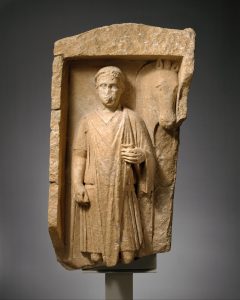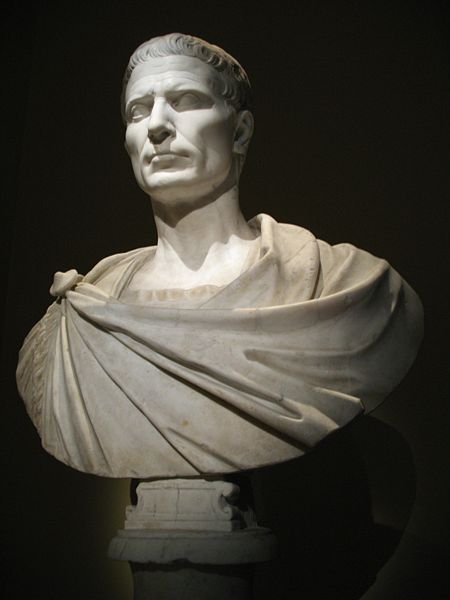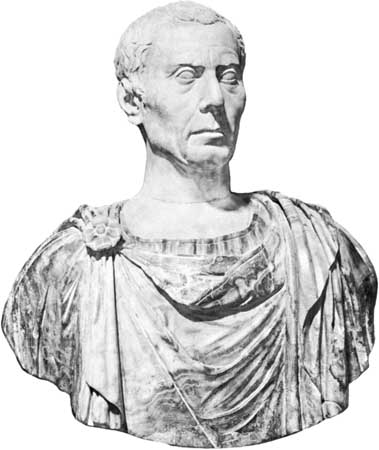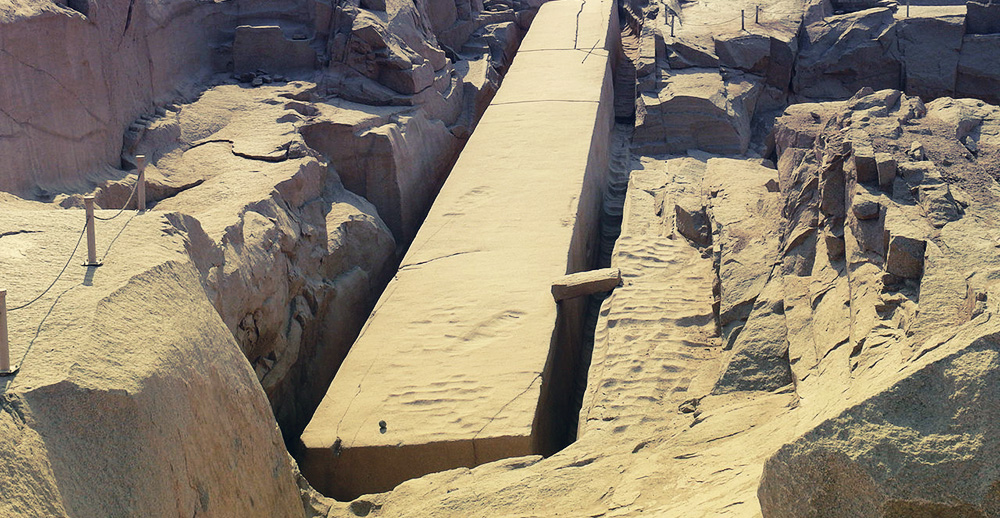This limestone sculpture of a man most likely dates from the first century BCE. At the Mount Holyoke College Art Museum, this object’s accession number is MH 1926.1.C.OI and was purchased with the Marion E. Hurlbut (Class of 1889) Memorial Fund. This object is currently in storage.
A Closer Look

It is unknown who this portrait at the Mount Holyoke College Art Museum is really supposed to represent. It could either be a private patron or an imperial family member. More likely than not this may merely be a Caesar look-alike, hoping to emulate or exude the emperor’s power by taking on his appearance. The structural carvings along the back side of his head show how the sculpture was originally mounted. This mounting could have taking the form of a funerary monument (see right).

As early as October of 1929 it was said in an issue of Mount Holyoke Alumnae Quarterly that this portrait “of the late Republican period [is] reminiscent of the portraits of Julius Caesar. . . .” This sculpture does include some characteristics of Julius Caesar portrayals including an asymmetrical skull, receding hairline, and weathered skin. As seen in coinage, Julius Caesar was also represented with a prominent Adam’s apple (see left). 1 From 1929 on, even to this day, it has been debated back and forth as to who this man was and when his portrait was made.
Context

Roman portraiture portrayed the fashion and social stereotypes and trends unique to the time that they were made. The idea of a private portrait originated with the Romans and was often associated with funeral rites and memory. 2 In addition, portraits of the emperor and his family were also popularized to “enthuse the masses.” 3 Funerary images were an ancient tradition that can be seen throughout the Italian peninsula. The Romans combined this tradition with Greek sculptural techniques to create ultra-realistic portraits. The Romans were not interested in classical beauty and instead emphasized real-life aspects of a person including occupation, age, or emotion. 4
The age requirement for a representative in Rome was forty. Veristic portraits often highlighted signs of aging to show the wisdom that comes with age, the hardships of a politician, and a concern for the well-being of the Republic. Anyone who ordered a portrait could be made to look like a well-to-do statesman. 5 The primary purpose of these portraits, as mentioned, were for memorial reasons for both ancestors and the living imperial family. Very few original private portraits are known and many are first or second century CE replicas. Portraits would have been part of ancestor galleries. As time went on, these galleries were added to, combined, and changed and they needed upkeep. Portraits were remade, copied, and often slightly updated with the period trends. 6

Some argue that this bust at the Mount Holyoke College Art Museum depicts the Roman emperor, Julius Caesar. Julius Caesar, or Gaius Julius Caesar, was born around 100 BCE and was assassinated by a group of nobles in the Senate House on March 15th, 44 BCE. His family, or gens, were the Julii who were members of the patrician class, Rome’s original aristocrats. At the time of Julius Caesar, this family was not incredibly influential. They did, however, trace their lineage to the goddess Venus, which became a common symbol for Julius Caesar during his rule. After a successful political career and a show of military dominance, Julius Caesar assumed the role of a dictator and began a dynasty that would rule over the Roman Empire for generations. Though not personally well liked, Julius Caesar won the respect of his military though his leadership and could sway his people in any direction through his political speeches and mastery of propaganda. 7
Manufacture
The bust itself is made of a yellowed limestone. Limestone technology was utilized and expanded upon in the Mediterranean as early as 300 BCE. It would not be uncommon for a sculpture to be made of limestone. The Romans created a kind of lime cement which hardened both underwater and in the air. 8 Limestone was relatively easy to work with and would be used for sculptures that would not have been frequently exposed to the elements. Limestone in its purest form would have been quarried from far away locations and dragged with a series of ropes and wooden sleds. This would have taken hundreds of slaves and was very dangerous.

Works Cited
Frel, Jirí. Roman Portraits in the Getty Museum. Getty Publications, 1987.
Mount Holyoke Alumnae Quarterly, 1929
The University of Waikato. “Timeline – History of limestone uses.” Science Learning Hub. Last modified August 20, 2012. http://sciencelearn.org.nz/Contexts/A-Fizzy-Rock/Timeline.
Toynbee, Arnold Joseph. “Julius Caesar: Roman Ruler.” Encyclopædia Britannica. Last modified August 6, 2015. https://www.britannica.com/biography/Julius-Caesar-Roman-ruler.
- Jirí Frel, Roman Portraits in the Getty Museum (Getty Publications, 1987), 17 ↵
- Frel, Roman Portraits in the Getty Museum, 2. ↵
- Ibid., 4 ↵
- Ibid.,2 ↵
- Ibid., 3 ↵
- Ibid., 4 ↵
- Arnold Joseph Toynbee, “Julius Caesar: Roman Ruler,” Encyclopædia Britannica, Last modified August 6, 2015, https://www.britannica.com/biography/Julius-Caesar-Roman-ruler. ↵
- The University of Waikato, “Timeline – History of limestone uses,” Science Learning Hub, Last modified August 20, 2012, http://sciencelearn.org.nz/Contexts/A-Fizzy-Rock/Timeline. ↵